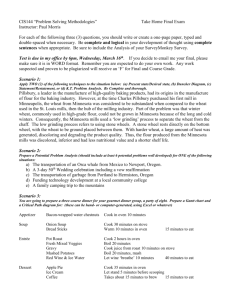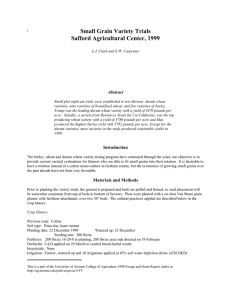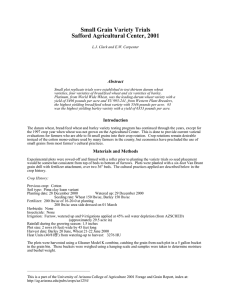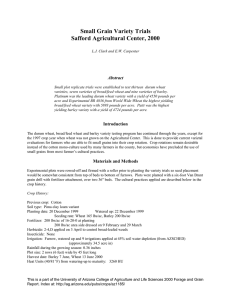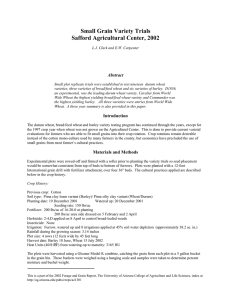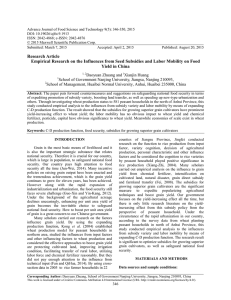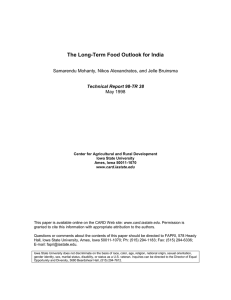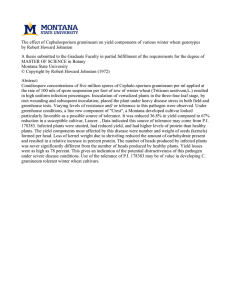Breeding for Quality..
advertisement
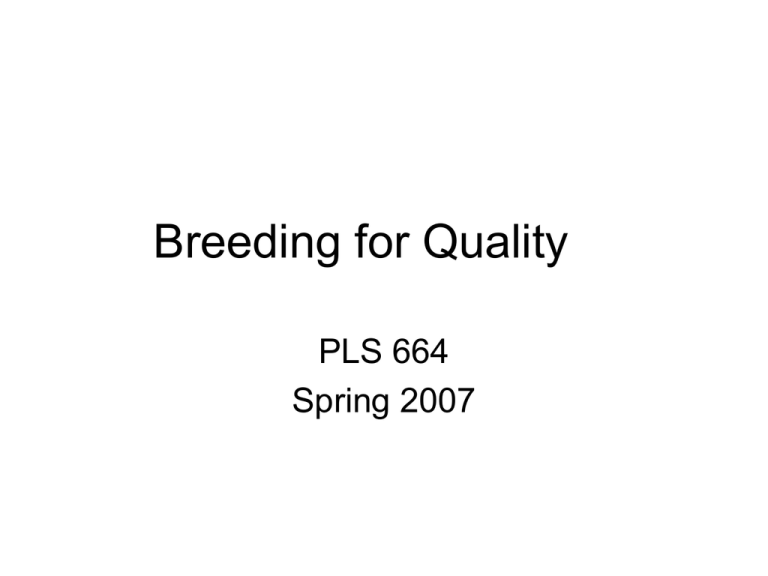
Breeding for Quality PLS 664 Spring 2007 End Use Quality - what is it? SRW Wheat - An Example SAMPLE NO. * 1401 1402 1403 1406 1414 1418 1419 1420 1421 1422 ENTRY STD =McCORMICK 1 McCormick 2 KY00C-2025-01 3 KY00C-2025-02 7 KY00C-2025-06 22 KY00C-2039-03 42 KY00C-2053-01 43 KY00C-2053-02 44 KY00C-2053-03 45 KY00C-2053-04 47 KY00C-2126-01 MILLING BAKING QUALITY QUALITY SCORE SCORE 67.6 C 48.2 E 67.6 C 48.2 E 64.1 C 44.7 E 66.3 C 49.5 E 73.4 B 56.9 D 71.5 B 32.7 F 83.2 A 82.9 A 75.3 B 72.8 B 77.6 B 70.0 B 77.7 B 78.8 B 62.3 C 55.7 D Typical Quality Evaluation Scheme • F4:6 lines from Preliminary Trials - send 100200 g to USDA Quality Lab for micro tests • F4:7 lines - same • F8:9 lines - send to quality lab for larger scale milling/baking tests • F8:10 lines - variety release candidates are entered in wheat quality council trials In-House Quality Tests • Quality analysis based on wheat meal rather than flour • Able to produce with inexpensive grinder • Measure overall soft wheat quality • Predict gluten strength In-House Quality Tests • • • • Why do these tests? Possible added value for grower Extra $$ in grower’s pocket Identify lines that you might otherwise discard • Identify lines that may be good parents Wheat Meal SDS Sedimentation Volume Results 2005 & 2006 SDS Sedimentation Source F-Value Lex05 2006 Lex06 Prn06 7.50*** 3.00*** 4.33*** 2.62*** Loc*Line n/a 1.58*** n/a n/a CV n/a 15.51 11.86 19.40 HBS2 HR2 n/a 0.67 0.41 0.77 0.62 Line Results-Regression WM- and Flour- Based Assays 130 Lexington, KY R2 = .44 Flour Lactic Acid Retention (%) 120 110 100 90 80 70 4 5 6 7 8 9 10 11 12 13 14 Wheat Meal SDS Sedimentation Volume (mL) 15 16 17 18 Genetic Progress over Time • Was found that progress in winter wheat over time was much greater than in spring wheat • Can attribute this difference to very strict quality requirements of spring wheat varieties • Canadian spring wheats show the least progress Recommended malting barleys • Growers are encouraged to contact their local elevator, grain handler or processor to gauge market demand for any variety grown in their region prior to seeding. 2006 crop plantings by variety are included at the end of this announcement. • Changes from 2006: The two-rows, CDC Copeland, Conrad, and Craft have been added to the list. • Recommended Six-Row Malting Barley Varieties • Variety Year* Variety Year* • Drummond 2002 Robust 1984 • Excel 1990 Stander 1995 • Foster 1997 Stellar-ND 2006 • Lacey 2000 Tradition 2004 • Legacy 2001 HRW Quality: Decline over Time? • Cox et al., 1989 • Perception and grumbling among bakers mainly, that “quality isn’t what it used to be” • “Old Timer” study conducted • 40 HRW wheats released over 70 years evaluated for quality traits HRW Quality • Regression coefficients show: – Flour protein increased more rapidly in recent years – Quality index increased more rapidly in recent years – Flour yield varied according to environment HRW Quality • Regression coefficients show: – Quality index increased more rapidly over time than did grain yield (p.630, paragraph 2) – This was in contrast to the conventional wisdom of millers and bakers that quality had declined because breeders were selecting only for yield HRW Quality • “This parallel improvement is not a contradiction of the general crop breeding axiom that yield and quality, especially as indicated by protein concentration, are negatively related. If breeders had selected for only yield or only for quality, it is likely that either trait could have been improved more rapidly. But they selected for both and improved both.” Genetic Progress G Sh 2 Where S = selection differential and h2 = heritability G ih P 2 Where i = selection intensity and P = phenotypic standard deviation Genetic Progress G ih P 2 Given that h2 and P are parameters of the population we are working with, what can we do to increase progress? We must increase selection intensity. Increasing Selection Intensity Family Seln. Mass Seln. Popn. Size 200 1000 No. Selected 20 40 Effective Popn. 40 Size Seln. Intensity 10% 40 4% Correlated Traits • Consider the composite trait T=Y+Q • Then GT GY GQ • Which means that the total genetic gain consists of both the direct and indirect response to selection for yield and quality. Direct and Indirect Response • It is intuitively reasonable that if we are dealing with two “must have” traits like yield and quality, then we do NOT want to limit genetic variation for either trait • Therefore we must evaluate bigger populations Quality Population Size Yield Farmers vs. End Users • Farmers - want premiums • End users - think in terms of discounts • Where is the happy medium Farmers vs. End Users • Industry benefits from cooperation • Advantages of contract growing • Identity preserved system Scab Resistance - A Quality Trait • Millers call it their top quality trait • Will they pay for it? • Will farmers give up some yield for it?
